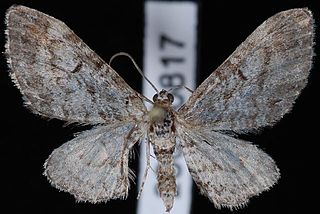
The shark is a moth of the family Noctuidae.

Photedes minima, the small dotted buff, is a species of moth of the family Noctuidae. It is found in Europe.

Eupithecia venosata, the netted pug, is a moth of the family Geometridae. It was first described by Johan Christian Fabricius in 1787. It is found across the Palearctic ecozone from Portugal and Morocco in the west to the Lake Baikal in Siberia and Afghanistan and Pakistan in the east.

Eupithecia costalis is a moth in the family Geometridae first described by Francis Walker in 1863. It is widespread in the tropical and subtropical lowland regions of east and south-east Asia, from Taiwan to India, Sri Lanka Borneo, Borneo, to Hong Kong.
Eupithecia costipicta is a moth in the family Geometridae. It is found in Afghanistan, India (Sikkim) and China. The habitat consists of mountainous areas at altitudes between 2,300 and 3,500 meters.
Eupithecia rosalia is a moth in the family Geometridae. It is found in the regions of Araucania and Los Lagos in Chile. The habitat consists of the Northern Valdivian Forest and Valdivian Forest biotic provinces.

Eupithecia graefi, or Graef's pug, is a moth in the family Geometridae. The species was first described by George Duryea Hulst in 1896. It is found in North America from south-western Alberta west to Vancouver Island, north to Alaska and south to California. The habitat consists of wooded areas.
Eupithecia chrodna is a moth in the family Geometridae first described by Herbert Druce in 1893. It is found in Mexico.
Eupithecia lugubris is a moth in the family Geometridae. It is found in Peru.
Eupithecia melanograpta is a moth in the family Geometridae. It is found in Peru.
Eupithecia nigripennis is a moth in the family Geometridae. It is found in Peru.
Eupithecia oroba is a moth in the family Geometridae first described by Herbert Druce in 1893. It is found in Mexico and Panama.
Eupithecia pieria is a moth in the family Geometridae first described by Hamilton Herbert Druce in 1893. It is found in Mexico and Bolivia.
Eupithecia regulella is a moth in the family Geometridae. It is found in Peru.
Eupithecia sticticata is a moth in the family Geometridae. It is found in Peru.
Eupithecia sylpharia is a moth in the family Geometridae. It is found in Brazil.
Eupithecia venulata is a moth in the family Geometridae. It is found in Peru.
Eupithecia versiplaga is a moth in the family Geometridae. It is found in Peru.
Eupithecia yangana is a moth in the family Geometridae. It is found in Ecuador and Peru.
Megalopyge undulata is a moth of the family Megalopygidae. It was described by Gottlieb August Wilhelm Herrich-Schäffer in 1858. It is found in Brazil, Paraguay and Argentina.




